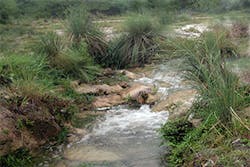Hydrogeology 101: Groundwater Analysis, Techniques, and Applications
Considering that one quarter of all U.S. rainfall becomes groundwater and groundwater represents 90% of our freshwater supplies, being able to accurately analyze your groundwater is essential. Whether you’re conducting groundwater studies for your erosion control projects or looking to bridge the gap (and talk the talk) with your hydrogeologists, we’ve got you covered.
Join Dr. Matthew Uliana for a 2-session webinar series exploring hydrogeology and groundwater systems, including: the fundamental hydrogeology concepts and theories; common equations and calculations; data collection and analysis techniques; and how you can apply these to your groundwater studies.
This webinar will be available live on Tuesday, Sept. 29th & Thursday Oct. 1st, 11:00 a.m. – 12:30 p.m. PDT / 2:00 p.m. – 3:30 p.m. EDT, and available on-demand after the live event. Register for the event by clicking the button below.
In this comprehensive 2-session live and on-demand series, we’ll cover the following hydrogeology and groundwater topics:
- Hydrogeology 101, Part 1:
In part one, we’ll cover the core concepts of hydrogeology and
groundwater systems, data collection, and analysis. We’ll open our
discussion with a look at groundwater within the hydrologic cycle,
and its key concepts, elements, and terms (e.g., aquifer, recharge, etc.).
Building on this foundation, we’ll take a look at hydraulic gradients
(the distribution of fluid energy in groundwater systems), the properties
of porous media, and how you can apply these effectively to Darcy’s
Law – the primary equation relating hydraulic gradients to discharge
through porous media. Additionally, we’ll examine the key concepts
and techniques for studying groundwater systems, including a
discussion on wells, characterizing recharge and discharge,
understanding aquifer storage, and groundwater quality. - Hydrogeology 101, Part 2:
In part two, we’ll move beyond the core concepts and into application
and analysis. We’ll start our discussion with the practical applications
of using Darcy’s Law for estimating fluid velocity in the subsurface.
Dr. Uliana will then cover the basics of well hydraulics, including a
discussion of aquifer response to pumping from a well (e.g., drawdown)
and how the different types of aquifers respond to pumping. We’ll take
a look at the Theis equation, and outline how you can use it to predict
aquifer drawdowns and implement it into common spreadsheet
programs for analysis. Building on this, we’ll explore the use of the
Theis equation in aquifer testing and discuss how you can use this
equation to determine permeability and storage parameters for aquifers.
Additionally, we’ll take a look at groundwater quality in detail, including
the: geochemical parameters and data needing collection; proper
sampling methods; how to calculate charge balance errors in
analytical data; and the geochemical data. Finally, we’ll discuss the
processes that affect liquid and dissolved contaminants transport in
the subsurface.
Learning Objectives
Attendees can expect the discussion and education of the following learning objectives.
Part 1
- Understand what an aquifer is and what differentiates an aquifer from other groundwater systems.
- Understand how water is distributed in the subsurface and differentiate between the unsaturated, saturated, vadose, and phreatic zones.
- Understand the distribution of fluid energy in a groundwater system (i.e., the hydraulic gradient) and how that controls the movement of groundwater.
- Understand the fundamental quantitative parameters that are used to characterize porous media (i.e., porosity and permeability).
- Understand the dynamics of groundwater systems (i.e., recharge, discharge, and storage) and how we collect data to study those systems.
- Understand the foundation, elements, and basic applications of Darcy’s Law.
Part 2
- Learn how to apply Darcy’s Law in hydrogeologic studies.
- Understand wells, the basic hydraulics of flow to a well in an aquifer, and the effects of pumping from a well on water levels in an aquifer.
- Understand how to use the Theis equation to predict drawdowns in a well, including implementation of the equation in a spreadsheet program.
- Learn about the fundamentals of aquifer testing and understand how aquifer tests are performed and how the data are analyzed.
- Learn the basic chemical parameters and ionic constituents in
typical groundwaters. - Learn how to calculate a charge balance error for analytical data from a commercial lab on groundwater samples.
- Understand the basic general concepts concerning the processes that control the movement of contaminants in the subsurface.
Presenter:
Matthew M. Uliana, Ph.D., P.G.
Senior Hydrologist
TRC Environmental Corporation
Date: 2 Sessions, Sept. 29 & Oct. 1 11 a.m. PDT / 2 p.m. EDT, 1-1.5hr*
Credits: 3 PDHs / 0.3 CEU
Cost: $149.00



